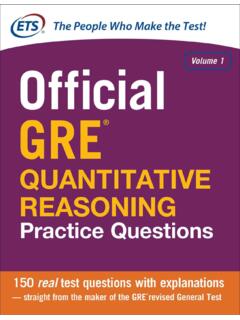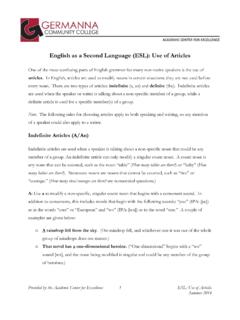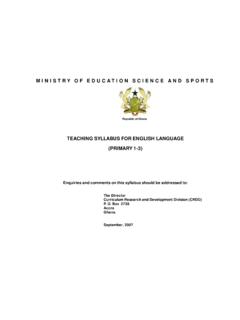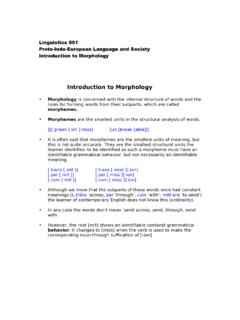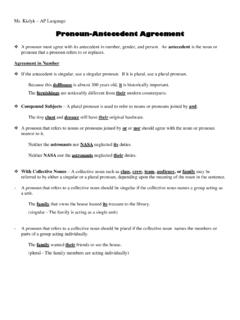Transcription of Common Mistakes in English
1 Common Mistakes in English with Exercises by T. J. Fitikides, Senior English Master The Pancyprian Gymnasium, Nicosia Author of Key Words for Easy Spelling Lessons in Greek- English Translation Errors, like straws, upon the surface flow; He who would search for pearls must dive below. John Dryden Pearson Education Limited Edinburgh Gate, Harlow Essex CM20 2JE, England and Associated Companies throughout the world This edition Pearson Education Limited 2002 The right of Timothy Fitikides to be identified as author of this work has been asserted on his behalf in accordance with the Copyright, Designs and Patents Act 1988. All rights reserved; no part of this publication may be reproduced, stored in a retrieval system, or transmitted in any form or by any means, electronic, mechanical, photocopying, recording, or otherwise without the express permission of the Copyright holders.
2 First published 1936 Second edition 1937 Third edition 1939 Fourth edition 1947 Fifth edition 1963 Sixth edition 2002 Printed in Malaysia ISBN 0 582 34458 1 Formatted by CjB Editorial Plus Preface Preface to the first edition This book has been designed to meet the requirements of students whose mother tongue is not English , Its main purpose is to help to correct the Common Mistakes to which foreign learners of English are liable. The method adopted throughout this work is uniform. All the errors dealt with are singled out, for they have to be recognised before they can be corrected: then correct forms are substituted for incorrect ones; finally, simple explanations are given wherever necessary to justify particular usages.
3 Exercises are set al the end to ensure that the principles may become firmly fixed in the students' minds. !t is no! claimed that this manual is exhaustive. Nevertheless, the difficulties tackled are real, and the examples arc representative of the Mistakes commonly made by foreign students of English , being the result of observations made over a long period of time. Much care has been given to the preparation of the Index, which it ?s hoped will make the book a useful work ol reference. My acknowledgements are due to MrVV. H G. Popplestone. who has read my manuscript and made many valuable suggestions. T..J. F August J Preface to the Sixth Edition It is now more than 60 years since this book was first published.
4 It has gone through many revisions, and additions have been made at different times in its history. With the millennium approaching it was decided that there were some points of usage which are no longer relevant and so this new edition has been prepared. The content has been completely reviewed in the light of modern English usage, and the type-faces and design up-dated for clarity. And yet the original concept and, indeed, most of the original Mistakes listed, are still pertinent to students of English even in the year 2000. This little book has sold several hundred thousand copies all over the world and seems likely to go on doing so. The author's note on how the book should be used is on page vti, with an addition for this edition.
5 Useful lists and summaries Have another look Prepositions after certain words 14 Use of the gerund 19 Use of certain tenses 27 Negatives 37 Third person singular, simple present 50 Indefinite article 53 Verb TO BE 55 Definite article 68 Questions 79 Correct order of words 82 Use
6 Of certain prepositions 88 Use of will and shall 106 Singular and plural 130 Irregular verbs in everyday use bear to He 198-199 light to write 200-201 How this book should be used Tliis book is intended for two uses, it may be used as a reference book and as an ordinary text book.
7 As a book of reference it should be consulted with every composition. The teacher may refer the student to the appropriate section dealing with his mistake by a number in the margin of his exercise book. For example, a misuse of a preposition of time (at, on or in) is indicated by 383 in the margin to enable the student to look up his mistake and correct it. This method has been tested and found more effective than the Common practice of writing the correct form for the student. It is axiomatic that the greater the student's individual effort, the more thorough will be his learning. With regard to its second use. as an actual text book, we strongly recommend that the teacher should start off with the exercises on pages 137 to are arranged under the headings of the various parts of speech: nouns, adjectives, pronouns, etc.
8 However, before an exercise is attempted, the teacher should make certain that the students have comprehended the particular usage involved. An occasional reference to some specific section may be made whenever this is deemed necessary, but under no circumstances is it advisable to go through the various sections of the book consecutively- or to commit to memory rules concerning usage. Despite the fact that this book has been designed for two separate uses, the writer is of the opinion that the best results will be achieved if it is used by the student both as a text book and as a book of reference. January 1961 While the above is still true, there is also a self-study use for this little book.
9 With more varied teaching materials available now, it can also be used as a self-study book by VII Contents Part 1 Misused forms Using the wrong preposition 1 Misuse of the infinitive 13 Use of the wrong tense 18 Miscellaneous examples 28 Un- English expressions 40 Part 2 Incorrect omissions Omission of prepositions, 46 Miscellaneous examples 49 Part 3 Unnecessary words Unnecessary propositions 61 Unnecessary articles 63 Use of the infinitive 69 Miscellaneous examples 70 Part 4 Misplaced words Wrong position of adverbs 75 Miscellaneous examples 77 Part 5 Confused words Prepositions often confused 83 Verbs often confused 89 Adverbs often confused 107 Adjectives often confused 109 Nouns often confused 116 Confusion of number 122 Confusion of parts of speech 129 Exercises 137 Index 182 How this book should be used students of English as a foreign language who are preparing work either as part of their studies or for their occupations.
10 With a view to this, it is suggested that, when a question of correct usage arises, the student should look first for the core word in the index and so find the section detailing the usage. For example, is it by foot or on foot? Look up foot in the index and you will be directed to Section 13 which will explain that on foot is correct. Students and teachers will decide for themselves what is the best way to use this book. What is constant is the quality of content and how helpful it is to all those who use English as a foreign language. VIII Part 1 used forms Using the wrong preposition Mistakes are often made by using the wrong preposition after certain words. The following list includes the words which most often give trouble: 1 Absorbed (- very much interested) in, not at.
